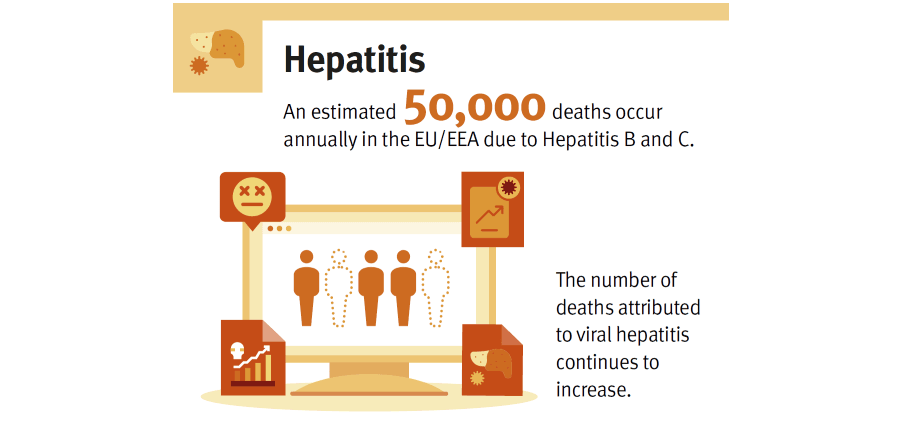 Credit: ECDC
Credit: ECDC28 Jul 2025 — Marking World Hepatitis Day, data from the European Centre for Disease Prevention and Control (ECDC) reveal a significant public health challenge. An estimated five million people in the European Union and European Economic area (EU/EEA) are living with chronic hepatitis B or C – infections that are leading causes of liver disease and cancer – with the majority of people unaware they are infected.
According to recent ECDC estimates, 3.2 million people are living with chronic hepatitis B and 1.8 million with chronic hepatitis C across the EU/EEA. In the EU/EEA, hepatitis B and C are linked to around 50 000 deaths each year – 15 000 related to hepatitis B and 35 000 related to hepatitis C – with deaths from liver cancer due to viral hepatitis continuing to increase. Furthermore, research suggests that over 65% of people with hepatitis B and 62% of people with hepatitis C are still undiagnosed and so not receiving care, putting them at a high risk of developing chronic liver disease and liver cancer.
Marieke van der Werf, Head of Section, Sexually-transmitted infections, blood-borne viruses and tuberculosis, said:
‘On World Hepatitis Day, we must underline the critical importance of scaling up efforts to prevent and control viral hepatitis. Chronic hepatitis leads to 50 000 preventable deaths each year, and the number of deaths from liver cancer are increasing. Prevention measures such as vaccination, improved access to testing and early access to care for individuals diagnosed with infection are essential for a healthier, more resilient Europe.’
Chronic hepatitis B and C can slowly damage the liver over years without causing any symptoms until they lead to serious conditions like liver cirrhosis and cancer. The longer that infections go undetected, the higher the personal and public health cost, making early diagnosis and linkage to care critical to break the chain of transmission and prevent avoidable deaths.
Childhood vaccination against hepatitis B, alongside programmes to prevent mother-to-child transmission, have reduced hepatitis B transmission across the EU/EEA, especially among younger age groups. However, the recent increase in newly reported cases of acute hepatitis B across the region may reflect increasing transmission and highlights the importance of maintaining comprehensive prevention programmes.
The 2030 United Nations Sustainable Development Goals (SDGs) include a global commitment to eliminate viral hepatitis as a public health threat, with concrete targets to diagnose 90% of people living with chronic hepatitis B and C, treat 80% of those eligible, reduce new infections by 90%, and cut hepatitis-related deaths by 65%. However, current data show that the EU/EEA is not on track: a large proportion of people infected with hepatitis B and C remain undiagnosed, and hepatitis-related deaths have not declined, with numbers of related liver cancer deaths continuing to increase. Therefore, current data indicate that the EU/EEA needs strong and immediate action to get on track to meet the 2030 SDG targets for viral hepatitis.
On World Hepatitis Day, ECDC renews its recommendations for EU/EEA public health authorities to scale up efforts to tackle viral hepatitis through these key measures:
Ensuring high vaccination coverage against hepatitis B through childhood vaccination programmes and for population groups at a higher risk of infection;
Improving access to testing for early diagnosis of hepatitis B and C;
Supporting harm reduction programmes to stop the spread of hepatitis B and C among people who inject drugs. This includes providing clean needles and syringes, safe places to use drugs under medical supervision, and access to testing and treatment;
Ensuring clear pathways to care and treatment. Effective treatments are now available for infections with hepatitis B and C that can reduce disease progression and the risk of severe complications such as liver cancer;
Providing accessible care to at-risk groups based on an understanding of their needs.
Hepatitis B – Annual Epidemiological Report 2023
Hepatitis C – Annual Epidemiological Report for 2023
Access all other related materials here.
Get involved
Are you living with HIV/AIDS? Are you part of a community affected by HIV/AIDS and co-infections? Do you work or volunteer in the field? Are you motivated by our cause and interested to support our work?
Subscribe
Stay in the loop and get all the important EATG updates in your inbox with the EATG newsletter. The HIV & co-infections bulletin is your source of handpicked news from the field arriving regularly to your inbox.
